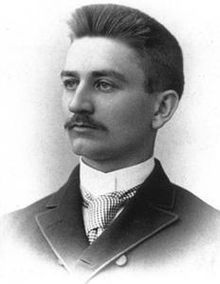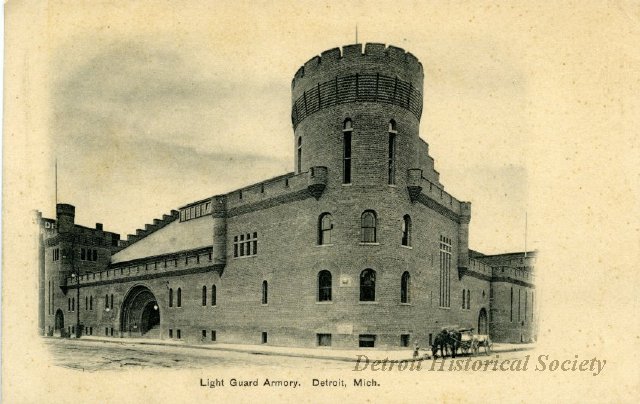On February 26, 1800, Lucius Lyon was born in Vermont. Lyon was the first elected U.S. senator to represent Michigan, but he had to be a non-voting member at first until Michigan became a state in 1837.
Lyon had submitted a petition for statehood in 1833, but a border dispute with Ohio over Toledo delayed the process.
Municipalities like South Lyon, Lyon Township in both Oakland County and Roscommon County and Lyons Township are all named after him.
Sources:
Michigan Every Day
Lucius Lyon wikipedia entry
On February 26, 1809, the Michigan territorial Gov. William Hull and the three judges of the Michigan Territory framed “an act concerning schools,” which allowed for the creation of local taxes of $2 to $4 per school child to support the territory’s poorer schools.
The session was held on a Sunday and was likely held in Richard Smyth’s tavern on Woodward Avenue near Woodbridge Street.
Source: History of Higher Education In Michigan; History of Detroit and Michigan
During the 1830s and 1840s, Burt and his crew surveyed much of Michigan. According to the U.S. surveyor general, Burt produced “the most satisfactory” work he had ever seen. Burt also invented the solar compass to work in areas where minerals in the ground might make the needles of their magnetic compasses act wildly and produce errors. Burt’s solar compass saved the U.S. government lots of money when the country’s western territories were surveyed.
Burt lived in Michigan from 1822 to 1858.
Source : Michigan Historical Calendar, courtesy of the Clarke Historical Library at Central Michigan University.
For more information, see Wikipedia
February 26, 1866 : Herbert Henry Dow born. Died October 16, 1930.
Herbert Dow, Age 3.
The son of a mechanical engineer and inventor, Dow displayed prodigious abilities in many capacities at an early age. He maintained a garden, held a job, assisted his father with many mechanical problems, and invented an incubator for chicken eggs all before age 12. As a high school student, he coinvented, with his father, a small steam turbine, which the U.S. Navy used for many years in torpedo propulsion. Dow graduated from Cleveland’s Central High School in 1884 and immediately enrolled in Case School of Applied Science, now known as Case Western Reserve University.
As a student at the Case School of Applied Science (now Case Western University) in Cleveland, Herbert abandoned his first senior thesis, “A New Method for Mining Native Copper,” halfway through his last year of college after he became dissatisfied with how his research was progressing. Instead he began to study boiler fuels and their chemical composition. For a college project, he tested gas wells in Ohio and Midland, Michigan. One day, a worker gave him a sample of the bitter brine he had found while drilling. The encounter left an impression on Herbert, who seemed to grasp that a sea of chemical raw materials flowed not far below the Earth’s surface.

Herbert Dow, Age 22.
Not long after he graduated, Dow came up with a more affordable method to extract bromine – which was used in medicines and photographic materials – from brine, and opened his first company, the Canton Chemical Company. It went bankrupt. The second, the Midland Chemical Company, opened in 1890. There he oxidized the brine by electrolysis, a method he also wanted to use to make sodium hydroxide and chlorine to be turned into bleach powder. His financial backers balked at his ideas for diversification and removed him from control. Realizing he would need a new company to move forward with the manufacture of chlorine, Herbert secured new investments and founded a third company, The Dow Process Company.
In 1896 he moved both company and family back to Midland, where the company’s name officially changed to The Dow Chemical Company in May 1897. From the very beginning, he vowed to make The Dow Chemical Company a research organization, devoted to developing new processes and extracting new products from brine. The company was an immediate success. Just three years later, his company absorbed Midland Chemical Company.
Eventually, Dow Chemical would grow to make many products from Midland’s brine in addition to bromine and chlorine, including calcium, magnesium, iodine, and sodium compounds. For many common consumer products, such as Epsom salt, Dow Chemical was the largest producer in the world
The world’s greatest chemical supplier at the onset of World War I was Germany. During the war, however, Britain blockaded Germany’s export ports. Dow Chemical began producing several desperately needed products that became difficult to get because of the blockade. Dow rose to the occasion by producing massive amounts of phenol for explosives; bromine for medicines and tear gas; chlorine for chloroform; sulphur chloride for smokescreens; monochlorobenzine for explosives; and magnesium for incendiary flares. By 1918, 90 percent of Dow’s production was in support of the war effort.
One of Dow’s greatest achievements during the era of World War I was synthetic indigo. Indigo dye, used primarily in textiles, was consumed in larger amounts than any other dye. The Dow Chemical Company was the first American chemical company to make synthetic indigo, shipping out the first indigo dye in March 1917.
After the War ended, Herbert Dow channeled his research into the automotive industry. With so much magnesium left over from war production, he researched what beneficial uses this extremely light metal could have. He decided that if magnesium were used to make replacement automobile pistons, it would give cars more speed, better fuel efficiency, and perhaps a little more zip. In his newly designed metallurgical laboratory, Dowmetal was born. Dowmetal pistons found the most success in racing vehicles, from boats to motorcycles. The 1921 the winner of the Indianapolis 500 used Dowmetal pistons in his vehicle.
Continuing in the automobile industry, Herbert Dow worked with General Motors in 1921 to create a “no-knock” gasoline. What resulted was tetraethyl lead, a fuel additive that had a high bromine content. Due to the enormous amounts of bromine needed to produce tetraethyl lead, Dow’s colleagues wondered where he could get such huge quantities of brine from which to extract bromine. To him, the answer was obvious—from the ocean.
The extraction of bromine from seawater would be Herbert Dow’s last significant undertaking. He died from cirrhosis of the liver in October 1930, just seven months after receiving the Perkin Medal “in recognition of his achievements in the production of bromine, alkalies, magnesium and its salts and alloys, and phenols, and for other developments in industrial chemistry resulting from the activities of his company.”
Willard H. Dow, who took over The Dow Chemical Company after his father’s death, completed his father’s project of extracting bromine from ocean water. The first plant built to extract bromine from seawater opened on the North Carolina coast in 1934.
The Dow logo evolved from the doodles of Herbert Dow in 1918. Dow noticed that his employees used to mark shipping containers with four slashes, forming a diamond shape, and the name “DOW” inscribed within the slashes. Dow himself worked over his scribblings with two other staff members, making minor adjustments. Shortly after, the Dow logo was born. By 1919, the Dow logo was internationally recognizable. The logo today looks basically the same as it did on Herbert Dow’s scratch pad more than 80 years ago.
Some Midlanders wondered why a pretty young woman like Grace Ball would waste her time on a young man who had no money and seemingly not much of a future. Their courtship consisted of notes carried by one of Grace Ball’s students between the two young people. One observer commented, “If those two don’t get married, that boy is going to wear himself out riding that bicycle.” They married on Nov. 16, 1892 and their marriage seemed an omen of better things to come. Finding new partners to furnish money for a factory, Dow purchased 10 acres of land on the east end of Main Street on the banks of the Tittabawassee River, dug two brine wells, put up some wooden buildings and The Dow Chemical Co. was incorporated on May 18, 1897 to make bleach. Herbert and Grace became parents of Helen (1894), Ruth (1895), Willard (1897) and Osborne (1899). And in 1899, the young Dow family moved into their new home on West Main Street — the only home that Dow ever owned.

Herbert Dow literally put down roots in Midland. The orchards and gardens he planted around his home offered not only relaxation and an opportunity to research agricultural chemicals during his lifetime; they are now part of his legacy to the community. For more information, see Dow Gardens.
Sources:
Virginia Florey, “The Legacy of Herbert Henry Dow“, Midland Daily News, Ocrober 7, 2015.
The Making of a Successful Entrepreneur courtesy of the Dow Chemical Company
Chemical Heritage Organization Herbert Henry Dow entry
Lansing Michigan Walk of Fame : Henry Herbert Dow
Herbert Henry Dow wikipedia entry
Growth Company: Dow Chemical’s First Century, by E.N. Brandt, published by Michigan State University Press
February 26-March 1, 1902

Photo of the Detroit Light Guard Armory (Detroit Historical Society)
Between February 26 and March 1, 1902, William E. Metzger, president of the Tri-State Automobile and Sporting Goods Association, charged the public 25 cents to attend an automobile and sporting goods show at the Detroit Light Guard Armory.
According to the Detroit City Directory, thee were now 10 automobile dealers in Detroit, with Metzger’s establishment on the Northwest corner of Bush Street and Jefferson Avenue touted as the largest in the United States. Although some of the attendees might have been more interested in the sporting goods, including bicycles, displayed, large crowds did turn out to see competitions between electric, steamer, and gasoline vehicles. R.D. Camp’s rollers and and dials measured auto speeds at what was billed the Speedonome. (It was the last year the Speedonome was available for the show since it was subsequently purchased by the Olds Motor Works for internal vehicle testing.)
Was it the first official auto show in Michigan? Readers may want to take a look at Robert Szudarek’s The First Century of the Detroit Auto Show and make their own decision. William Metzger and Seneca G. Lewis (from the Fletcher Hardware Store Sporting Goods Department) actually organized the Tri-State Automobile and Sporting Goods Association in 1899 and started leasing the Detroit Light Guard Armory for shows. During the first years, autos were only a small part of the featured event. In 1900 Metzger is credited with organizing the first recognized automobile show in New York City which was also sponsored by the National Association of Automobile Manufacturers and the Automobile Club of America. The main purpose of that event was to drum up dealers — who could sign licenses at the event. The public was not invited to attend.
However, by 1902 the annual event held in Detroit is credited by the Michigan Historical Society as the first automobile show in Detroit. And who are we to quibble?
Driving automobiles were still an adventure. There were few roads beyond the city limits. Nor were there signs, garages, gas stations, or road maps. In order to venture any distance, vehicles usually formed “packs” for touring. To improve conditions for automobile driving and sales, William Metger went on to create the Automobile Club of Michigan in 1902.
Sources :
Detroit Historical Society Blog
Robert Szudarek. The First Century of the Detroit Auto Show. Warrendale, Pa. Society of Automotive Engineers, 2000.
On February 26, 1905, Ann Arbor’s Mayor Arthur Brown decided to crack down on the city’s wayward students. Any minor who attended a school in the state could not frequent any saloon, bar room, dance hall, concert saloon, variety theater, billiard hall, or bowling hall in Ann Arbor without risking a $50 fine and 30 days in jail.
Source : Michigan Every Day.
On February 26, 1906, the nation’s first Shrine Circus was held in Detroit. It returns in April 2018 for its 112th year!
By 1906, Detroit was a thriving commercial and manufacturing center with a budding automobile industry. Circuses were common forms of winter entertainment in the city. But the Shrine Circus made news. Here’s how the Detroit Free Press characterized the first circus: “With a crash of cymbals and a blare of horns, punctuated by the discordant cries of barkers setting forth the merits of various side show attractions…From peanuts to baby elephants, from side show to ‘Grand’ concert, nothing was lacking to make the circus a complete success. … Clowns which caused the spectators to laugh themselves almost into convulsions disported themselves around the ring at frequent intervals. Seldom does an audience of such proportions so generally abandon itself to merriment as did last night’s gathering. The rafters fairly seemed to tremble with the gale was at its height.”
Shrine Circuses expanded throughout the country by the 1920s, featuring wild and domestic animal acts, feats of human daring and extreme skill, and the Shrine clowns. As the major fundraiser for the local Shrine, the Circus is the visual centerpiece for the organization. Bill Jackson, past Shrine potentate and circus administrator, is credited with summarizing the importance of the Circus: “The Shrine is our fun. The hospitals are our philanthropy.” Many changes in society have impacted the circus as an entertainment experience. While circus audiences waned through the 1990s, they have grown in recent years. Some present themselves as lavish shows while others are focused on acrobatics and music. The Shrine Circus remains a traditional, affordable family entertainment experience with the timeless qualities that charmed the first audience in 1906 — raising funds that remain in the community supporting the work of the local Shrine. As McConnell notes, the Shrine Circus inaugurated an entirely new entertainment concept in America. Today, it may still be the most attended circus – “the circus” for many families in large and small towns across the country. Thanks to the Shriners, this show will go on.
Who are the Shriners? They support what has been called the “World’s Greatest Philanthropy” — Shriners Hospitals for Children, a network of 22 pediatric specialty hospitals operated and maintained by the Shriners. All children, 18 years and younger, may be eligible for treatment at Shriners Hospitals; eligibility is not based on financial need or relationship to a Shriner. Shriners often help arrange and pay for transportation for children and parents to go to the hospitals; some drive families themselves. Shriners will be found participating in local parades, marching and sometimes riding in miniature sports cars, trucks, and fire engines; performing in an “Oriental” band dressed in Middle Eastern costumes or pipe and drum units, and, of course the family Shriner clown units. Despite its Middle-Eastern theme and Moorish architectural motifs, the Shriners are not connected to Islam. The only religious requirement is that all Shriners must profess a belief in a Supreme Being. While Shriners are men, there are two companion organizations, Ladies’ Oriental Shrine and Daughters of the Nile. They also support the Shriner Hospitals and share in activities like the clown units.
The Shrine Circus is returning to Detroit from April 12-15, 2018.
Sources :
Detroit Historical Society Facebook Page
On February 26, 1954, Michigan Rep Ruth Thompson (R) introduces legislation to ban mailing “obscene, lewd, lascivious or filthy” phonograph (rock & roll) records.
Much more noteworthy, Thompson was elected as a Republican from Michigan’s 9th congressional district to the 82nd Congress in 1950 and subsequently re-elected to the two succeeding Congresses serving from January 3, 1951 to January 3, 1957 in the U.S. House. She was the first woman to represent Michigan in Congress and the first woman to serve on the House Judiciary Committee.
Source : HistoryOrb.com and wikipedia

On February 26, 1957, Michigan Governor G. Mennen Williams signed a bill changing the name of Western Michigan College to Western Michigan University, making WMU the state’s 4th university.
Note : Campus and community members fill the Sangren Pedestrian Mall each fall for the Bronco Bash welcome-to-Western party.
Source :
James Minder resigned as CEO of Smith & Wesson at age 74, the country’s second-biggest handgun maker, when it was revealed he worked his way through the University of Michigan as a stick-up man. Minder spent 15 years in Michigan prisons for armed robberies and an attempted prison escape.
But wait, there’s even more to the story.
See Kim Clarke and James Tobin, “The Robber’s Third Chance“, University of Michigan Heritage Project.
Sources :
Historical Society of Michigan
“Smith & Wesson chief quits over crime; Chairman of the nation’s No. 2 gun maker resigns over past armed robbery; company names new chief”, CNN Money, February 27, 2004.






